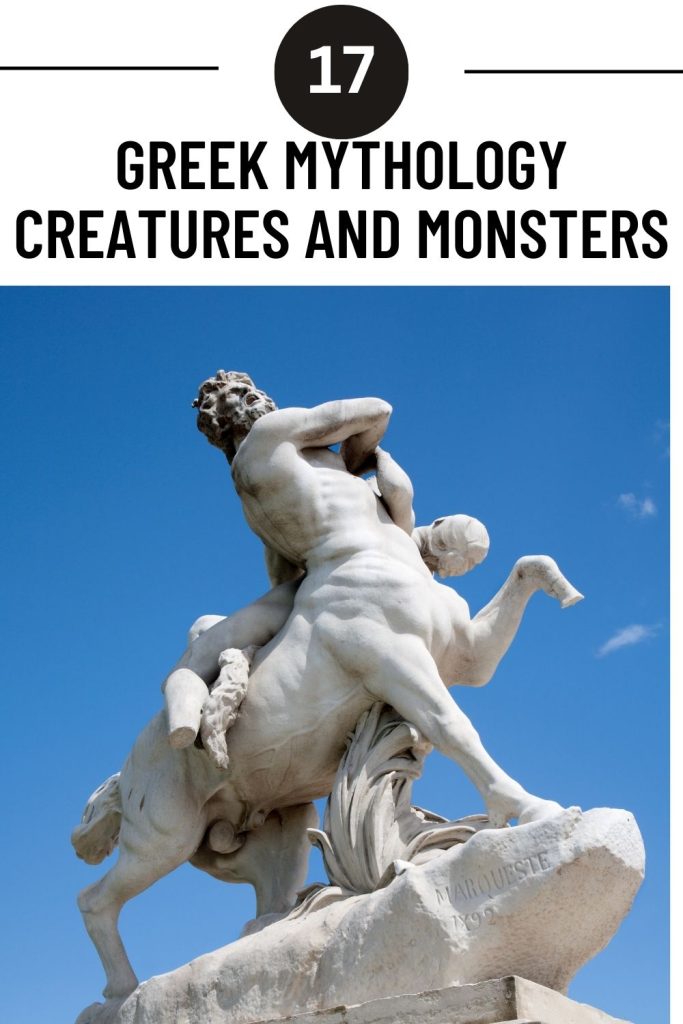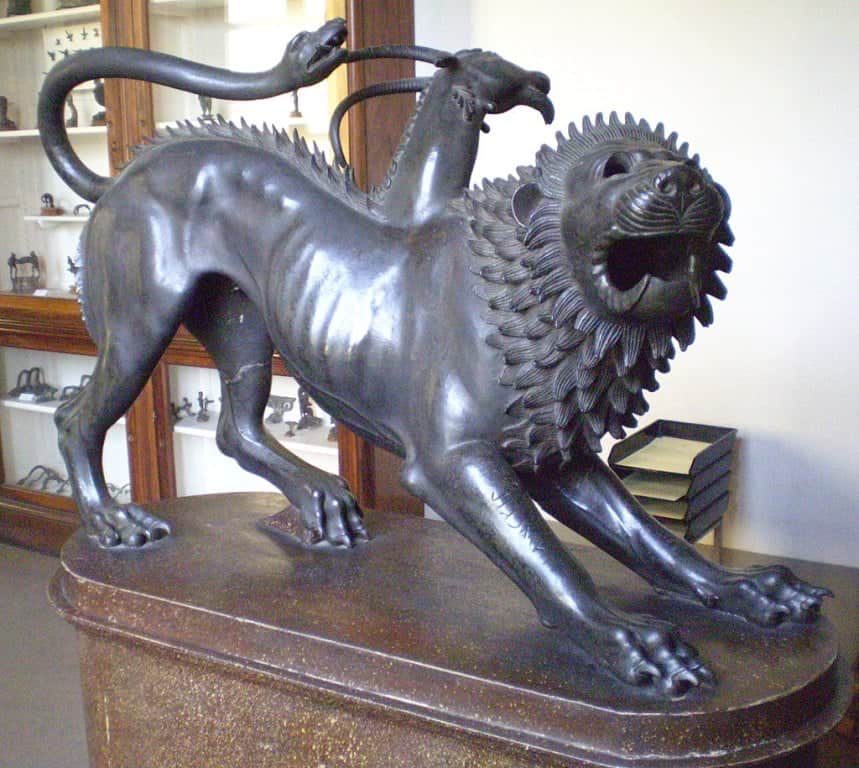Greek mythology is one of the most prevalent and famous ones in the Western world. Art, theater, and cinema have always been inspired by Greek mythology. The famously illustrious yet flawed Greek Olympian gods, the powerful demigods and heroes and the monsters that they created or fought have always captured the imagination.
Yet usually, it’s the gods and demigods that take center stage! The frightfully wondrous world of Greek mythology’s monsters is often overlooked, except for when they serve as antagonists. Not many are aware that the Ancient Greeks created a bizarre menagerie of terrible monsters with bizarre powers and a powerful impact on the lives of mortals.
Just like with the Greek gods, there are many to discover within the various myths and legends. Here are some of the most impactful, powerful, or bizarre ones that await for you to discover them!

Greek Mythical Creatures and Monsters to Know
Typhon
Typhon is the last son of Gaea, the primordial goddess of the Earth and the ancestral mother. Typhon is considered the deadliest, most dangerous, and most powerful of the monsters in Greek mythology.
He was said to have a hundred snake heads on his shoulders which churned out fire and poison, making all kinds of terrifying noise. Typhon also was serpentine, depicted with snake tails or the entirety of his lower body being that of a snake. He has giant dragon wings and several hands. From his hips there grow snake coils.
Typhon was so terrifying even the gods feared him. Zeus dealt with him eventually, shooting him with a hundred lightning bolts and casting him under Mt. Etna in Sicily. That’s why Mt. Etna is a volcano.
Echidna
Echidna is also called “the mother of monsters”. She is Typhon’s wife and is also serpentine: the bottom half of her is a giant serpent (with a single or several tails) while the upper half of her is of a gorgeous woman. She was fierce with terrible poison and lived in the Underworld, where Hades’ kingdom is.
From her union with Typhon, she gave birth to many monsters which became many heroes’ antagonists. Echidna’s name in Greek means “viper”. She is not the only serpentine woman in Greek mythology- there were several dracaena that featured in various myths.
Chimera
Chimera was a monster made of many different animal parts: it had the body of a lion which tapered off into the tail of a serpent. On its back, there was the head of a goat that breathed fire. Often, the Chimera has three heads instead of just two, as the serpent tail ends in a snakehead.
Chimera is said to have given birth to two other monsters: the Nemean Lion, which Heracles hunted as part of his twelve labors, and the Sphinx. Chimera was terrifying and unbeatable until the hero Bellerophon faced her with a lead-tipped spear.
When she opened her mouth to breathe fire on Bellerophon, he thrust the spear in it and the heat melted the lead, which filled up her gullet and suffocated her.
The Hydra
The Hydra was a terrifying sea or water-dwelling creature from Lerna in Argolis. That’s why it was called “Lernaean Hydra”. The Hydra was impossible to go near because its breath emitted poison. A human would die if its breath touched them. It is depicted as a giant serpent with nine heads, though some versions want the Hydra to start off with a single head.
The Hydra’s most terrifying feature was that if a head got chopped off, another two immediately sprung up in its place. Its bite was also poisonous and deadly. The monster remained invulnerable if it kept even one of its heads.
The Hydra features Heracles’ second labor. After trying to chop off its heads quickly to no avail, Heracles called his nephew Iolaus to help him. He held a flaming torch and each time Heracles chopped off a head, Iolaus would place the torch on the stump, preventing the two new heads from springing up. This continued until all heads were chopped off and Heracles could finally slay the Hydra.
Scylla and Charybdis
These two monsters are a pair, found in the pages of the Odyssey. They lived on opposite sides of a very narrow sea straight and prayed on sailors. Scylla was perched against the rockface. It had several serpentine heads that reached out into the straights to pick sailors off the passing boats.
The ships were forced to sail close to Scylla due to Charybdis: a terrible sea monster we never see, but which created a massive whirlpool that sucked under the entire ship. Odysseus sailed through the straight by opting to avoid Charybdis and go swiftly past Scylla so she wouldn’t have time to pick off his sailors. Despite that, Scylla caught six.
When he had to navigate back through the same straight on a raft he braves Charybdis. Though he survived by holding onto a fig tree, he lost the raft to the monster. Only because the raft had nobody else on it, Charybdis spits it back out and Odysseus manages to sail away.
The Gorgons
The Gorgons were three sisters, daughters of Typhon and Echidna. Their names were Stheno, Euryale, and Medusa. Medusa, who is also the most famous of the three, was the only one of the Gorgons who was not immortal.
Depictions vary when it comes to the Gorgons’ body: some depict them as having serpentine bodies from the waist down, but most give them regular humanoid bodies. It’s the Gorgon’s head that made them monstrous, terrifying, and deadly. They had large eyes, snakes instead of hair, big mouths with boar tusks, hideous rolling tongues, and sometimes even beards.
The Gorgon’s stare could turn anyone to stone. Medusa, the most famous one, was eventually slain by the hero Perseus who approached her with his back turned and staring into a special mirror to avoid her petrifying glance. He cut off her head while she was sleeping and stuck her head in a bag. He later offered the head to the goddess Athena who put it on her shield.
Sirens
The Sirens were birdlike creatures. Early on they were depicted as having the full body of a bird with the head of a beautiful woman. Later on, the Sirens were depicted as having the legs of a bird or a fish body from the navel down. They may or may not have wings, depending on the myth.
The Sirens lived on a small island full of jutting rocks and sea traps. They lured sailors with their divinely alluring, seductive songs and melodic voices. The sailors would sail too close to the island and smash the hull, getting marooned there. As soon as they stepped to shore, the Sirens devoured them.
Because of that, the only human who heard their song and survived was Odysseus, who instructed his sailors to tie him to the mast of the ship while they plugged their ears with wax to keep themselves from hearing the song and wrecking the ship. The ship sailed safely past and the sailors were oblivious to Odysseus’ pleas to release him so he could dive and swim to the Sirens.
The Harpies
The Harpies were monsters with the body of a bird and the head of a woman. Their faces were pale and ‘full of hunger’ and there were long talons in their hands or wings. They were notoriously cruel and violent, stealing food or humans with the fervor of wild winds.
They would also pin down and carry off mortals who had committed terrible crimes, carrying them off to the Erinyes, the goddesses of vengeance, to be punished. Anyone who suddenly disappeared was said to have been taken by the Harpies.
Lamia
Lamia was once a beautiful queen of Lybia. Zeus had an affair with her, causing Hera’s jealousy and wrath. Hera stole the children she had with Zeus and killed them. The grief turned Lamia insane. In her madness, she snatched any child she could find and ate it.
The more children she devoured the uglier she became until she was reduced to a hideous scaly, serpentine monster. Zeus granted her the power of prophecy and the ability to take out her eyes and reinsert them at will.
Later on, Lamia gave her name to the lamiai, demonic ghostly half-snake half-women spirits who seduced young men and then devoured them.
The Sphinx
The Sphinx was a monster with a lion’s body, bird’s wings, and a woman’s head. She was very wise but also very cruel. She would live by a road leading to the city of Thebes and stop passersby, demanding they answer her riddle.
If the traveler answered her riddle, then she let them through. If not, she would kill them and eat them. The problem was that nobody managed to answer her.
Oedipus was one such traveler who managed to solve the Sphinx’s riddle. As soon as he did, he took advantage of her surprise that a mortal managed to do so and killed her.
The Pegasus
Pegasus was a beautiful white horse with giant white wings. He was fathered by Poseidon and born from the blood of Medusa when Perseus cut off her head. Pegasus is extremely intelligent and noble. He won’t allow anyone with an impure heart to ride him and can see through the deception.
Pegasus allowed the hero Bellerophon to ride him so they could fly in and kill Chimera. But when he tried to reach the gods at the top of Olympus, he fell from Pegasus’ back to his death.
Mares of Diomedes
Also known as the Mares of Thrace, these four horses were powerful, wild, and uncontrollable. They were also man-eating. The taste of human flesh would calm them enough to be controlled, and the giant Diomedes fed people to them for this purpose.
Heracles was ordered to capture them as part of his labors. He did so by capturing Diomedes and feeding him to his own horses. After that, he tied their mouths and took them to Eurystheneus who tasked him with the labors. Eurystheneus gifted them to Hera.
Stymphalian Birds
These birds were said to be pets of Ares or Artemis. They were near the town of Stymphalis in Arcadia. They had bronze beaks and feathers made of metal. They could also shoot those metal feathers at people and their dung was poisonous. They flew in swarms, ate people, and destroyed crops until Heracles killed them with arrows spiked with blood from the slain Hydra as part of his labors.
Cerberus
Cerberus was a son of Typhon and the gatekeeper of the gates of the Underworld. He was a giant dog with three heads, also known as Hades’ Hound. Instead of a tail, he had a snake and there were many other snakes growing out of random parts of his body. Cerberus made sure no soul left the Underworld and no living mortal entered it.
Heracles captured Cerberus, with Hades’ permission, as part of his labors. Another hero, Orpheus, managed to make him sleep by playing divine music.
Centaurs
Centaurs were half-men, half-horse people who lived in the mountains of Thessaly. They were in constant war with the Lapiths nearby over the attempted abduction of the queen of the Lapiths during a wedding banquet.
One of the most famous centaurs was Chiron, a wise teacher, and excellent doctor who educated Achilles. Another one is Nessus, who was killed by Heracles and whose poisoned blood led to Heracles’ own death.
Cyclops
The Cyclops were one-eyed giants that were the first to inhabit the earth. They were excellent herders and huntsmen and they forged good weapons. They were also extremely aggressive and lethal to anyone who approached their territory.
Polyphemus is the most famous Cyclops who tried to eat Odysseus and his crew when they stopped by his island in search of shelter. Odysseus fooled him by giving him strong wine and then blinding him when he was asleep in a drunken stupor.
The Minotaur
The Minotaur was a monster with a bull’s head and a giant male human body. He was the product of Poseidon’s punishment: When he gave King Minos of Crete a snow-white bull to sacrifice to him, the king tried to keep it and replace it with a different bull. Poseidon realized this attempt to fool him and in revenge, he made Minos’ wife Pasiphae fall in love with the bull.
Desperate to unite with the bull, Pasiphae asked Daedalus to make her a cow suit so she could approach the bull. From that union, there came the Minotaur. He was man-eating and unstoppable so Minos commissioned Daedalus to make the Labyrinth for the Minotaur to dwell in. Eventually, the Minotaur was killed by Theseus who ventured into the Labyrinth to kill him.
photo credits: Chimera of Arezzo, National Archaeological Museum, Public domain, via Wikimedia Commons


